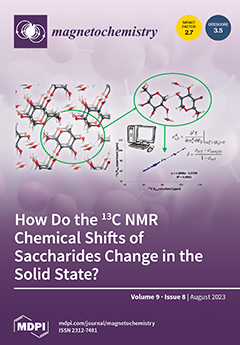In this study, Ni-Fe alloy nanoparticles were prepared using the proteic sol–gel method, followed by a reduction in H
2 at 500 and 700 °C, namely hereafter as NiFe-500 and NiFe-700, respectively. The morphological, structural, and magnetic properties were tuned via the thermal
[...] Read more.
In this study, Ni-Fe alloy nanoparticles were prepared using the proteic sol–gel method, followed by a reduction in H
2 at 500 and 700 °C, namely hereafter as NiFe-500 and NiFe-700, respectively. The morphological, structural, and magnetic properties were tuned via the thermal treatment in H
2. The samples were studied using XPS, TEM, Mössbauer spectroscopy, DC magnetic measurements, and electrochemical measurements. Ritveld refinements showed that the sample NiFe-500 has FCC (face-centered cubic) and BCC (body-centered cubic) NiFe alloys, while the sample NiFe-700 has only FCC NiFe alloy. For both samples, magnetization measurements in the range of 300–900 K showed the presence of the Griffiths phase, indicating the formation of clusters of either Fe or Ni-Fe alloys rich in Fe. The sample NiFe-500 presented ferromagnetic (FM) transitions at 533, 700, and 834 K, assigned to the alloys Ni
37Fe
63-FCC, Ni
46Fe
54-FCC, and Ni
55Fe
45-FCC, respectively. In contrast, we could not observe the FM transition of the BCC Ni-Fe alloy because of limitations in our experimental setup (T ≤ 900 K). Meanwhile, three FM transitions were observed for the sample NiFe-700 at 480, 655, and 825 K, attributed to the alloys Ni
34Fe
66-FCC, Ni
43Fe
57-FCC, and Ni
54Fe
46-FCC, respectively. At 5 K, the samples NiFe-500 and NiFe-700 have saturation magnetizations of 164.2 and 173.6 emu g
−1, respectively. For application in Oxygen Evolution Reaction catalysis, the samples NiFe-500 and NiFe-700 showed different overpotentials of 319 and 307 mV at 10 mA cm
−2. These low overpotential values indicate a higher electrochemical activity of the FCC Ni-Fe alloy and, for both samples, a superior electrocatalytic activity in comparison to RuO
2 e IrO
2 conventional catalysts. Furthermore, the samples showed high electrochemical stability in chrono potentiometric studies for up to 15 h. This current work highlights that the Ni-Fe alloys produced via the proteic sol–gel and with a reduction in H
2 methods can be promising for OER systems due to their good performance and low costs.
Full article





